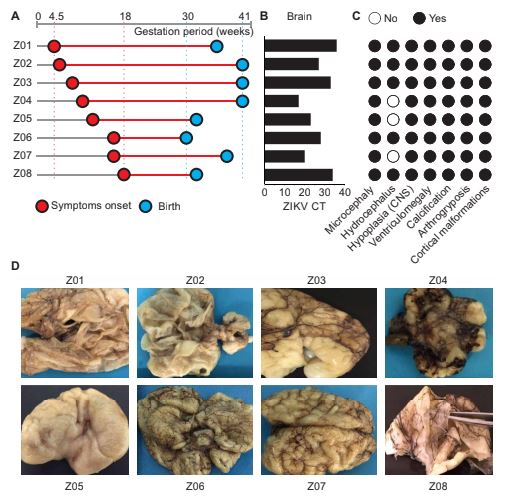Molecular alterations in the extracellular matrix in the brains of newborns with congenital Zika syndrome.
Zika virus (ZIKV) infection during pregnancy can cause a set of severe abnormalities in the fetus known as congenital Zika syndrome (CZS). Experiments with animal models and in vitro systems have substantially contributed to our understanding of the pathophysiology of ZIKV infection. Here, to investigate the molecular basis of CZS in humans, we used a systems biology approach to integrate transcriptomic, proteomic, and genomic data from the postmortem brains of neonates with CZS. We observed that collagens were greatly reduced in expression in CZS brains at both the RNA and protein levels and that neonates with CZS had several single-nucleotide polymorphisms in collagen-encoding genes that are associated with osteogenesis imperfecta and arthrogryposis. These findings were validated by immunohistochemistry and comparative analysis of collagen abundance in ZIKV-infected and uninfected samples. In addition, we showed a ZIKV-dependent increase in the expression of cell adhesion factors that are essential for neurite outgrowth and axon guidance, findings that are consistent with the neuronal migration defects observed in CZS. Together, these findings provide insights into the underlying molecular alterations in the ZIKV-infected brain and reveal host genes associated with CZS susceptibility.
Authors
Renato S Aguiar; Fabio Pohl; Guilherme L Morais; Fabio C S Nogueira; Joseane B Carvalho; Letícia Guida; Luis W P Arge; Adriana Melo; Maria E L Moreira; Daniela P Cunha; Leonardo Gomes; Elyzabeth A Portari; Erika Velasquez; Rafael D Melani; Paula Pezzuto; Fernanda L de Castro; Victor E V Geddes; Alexandra L Gerber; Girlene S Azevedo; Bruno L Schamber-Reis; Alessandro L Gonçalves; Inácio Junqueira-de-Azevedo; Milton Y Nishiyama; Paulo L Ho; Alessandra S Schanoski; Viviane Schuch; Amilcar Tanuri; Leila Chimelli; Zilton F M Vasconcelos; Gilberto B Domont; Ana T R Vasconcelos; Helder I Nakaya
External link
Publication Year
Publication Journal
Associeted Project
Systems Immunology of Human Diseases
Lista de serviços
-
StructRNAfinder: an automated pipeline and web server for RNA families prediction.StructRNAfinder: an automated pipeline and web server for RNA families prediction.
-
CEMiTool: a Bioconductor package for performing comprehensive modular co-expression analyses.CEMiTool: a Bioconductor package for performing comprehensive modular co-expression analyses.
-
webCEMiTool: Co-expression Modular Analysis Made Easy.webCEMiTool: Co-expression Modular Analysis Made Easy.
-
Assessing the Impact of Sample Heterogeneity on Transcriptome Analysis of Human Diseases Using MDP Webtool.Assessing the Impact of Sample Heterogeneity on Transcriptome Analysis of Human Diseases Using MDP Webtool.
-
Predicting RNA Families in Nucleotide Sequences Using StructRNAfinder.Predicting RNA Families in Nucleotide Sequences Using StructRNAfinder.
-
OUTBREAK: a user-friendly georeferencing online tool for disease surveillance.OUTBREAK: a user-friendly georeferencing online tool for disease surveillance.
-
Noninvasive prenatal paternity determination using microhaplotypes: a pilot study.Noninvasive prenatal paternity determination using microhaplotypes: a pilot study.
-
Editorial: User-Friendly Tools Applied to Genetics or Systems Biology.Editorial: User-Friendly Tools Applied to Genetics or Systems Biology.
-
Automatic detection of the parasite Trypanosoma cruzi in blood smears using a machine learning approach applied to mobile phone imagesAutomatic detection of the parasite Trypanosoma cruzi in blood smears using a machine learning approach applied to mobile phone images
-
Tucuxi-BLAST: Enabling fast and accurate record linkage of large-scale health-related administrative databases through a DNA-encoded approachTucuxi-BLAST: Enabling fast and accurate record linkage of large-scale health-related administrative databases through a DNA-encoded approach
-
Ten quick tips for harnessing the power of ChatGPT in computational biologyTen quick tips for harnessing the power of ChatGPT in computational biology

